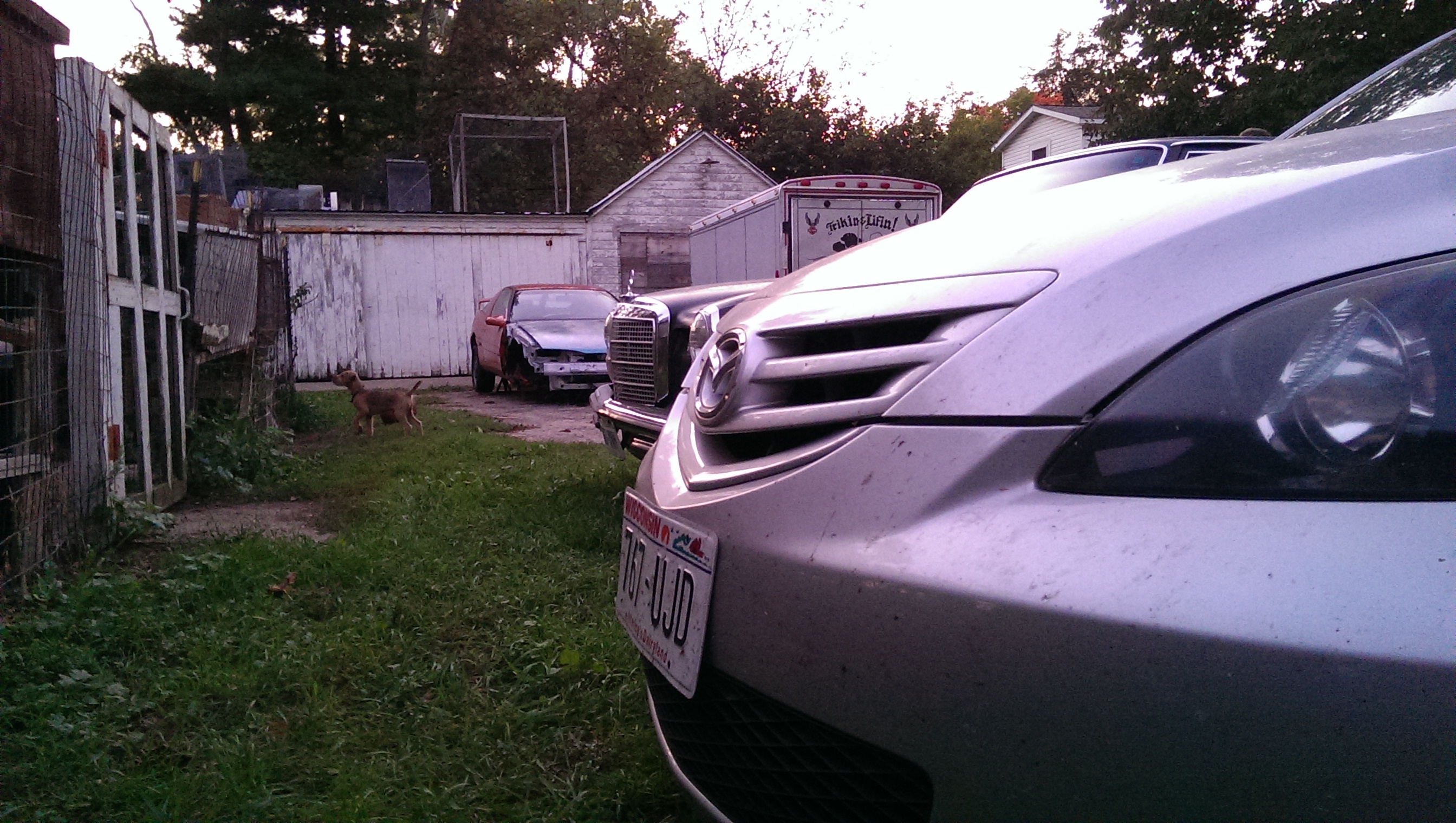Yep, back to the engine this week. I cleaned up a few more things (I thought I was done with that!) and got a few more things attached. I also managed to run into a few road blocks.
The first thing I did was more painting, I want the intake, valve cover, and exhaust to complement each other and the running theme of aluminum/copper so I did some highlighting. Yes, cutting the tape for this is exactly as time consuming as you imagine it is.






The affect is completely worth it though. It’s awesome what a bit of paint, tape, a razor blade, and some patience can accomplish.






After that it was on to cleaning the thermostat housing and fuel rail. The fuel rail got a nice coat of copper as it nestles right in over the intake on that side of the head. It will help break up some of the aluminum up there. The thermostat housing got a nice clear coat to bring out it’s best dark metal look and keep it from corroding to nastiness again. I also replaced the thermostat with a new OEM temperature thermostat. The thermostat that was in there was set to a lower temperature, which isn’t really great for a street car, and I didn’t want to rely on the motorad part after I had a bad experience with one in the Mazda.




Next, I cleaned off the filthy oil pan. I didn’t grab any shots before hand, so you’ll just get to see the rusty (but clean!) product of my scrubbing. To get it nice and clean I went with the parts washer, then a nice brake clean shower, and an air clean after that. The oil pickup needed to be cleaned and attached before the pan can go on, and I had to make a gasket for where it attaches to the oil pump. Apparently a Victor Reinz “full gasket set” is not actually a full gasket set.




I also received my poly motor mounts on Saturday, these are inserts that are much more stiff than the oem rubber motor mount inserts. People use these to eliminate any chance of wheel hop or engine movement, in return you ensure that the power isn’t lost by rocking the engine, it all goes directly to the ground. It also channels all the undampened vibrations into the body of the car, so you will feel your engine more. I’ve removed my balance shafts, so that may compound the issue. I also had my engine balanced while it was being worked on, so that may help keep vibrations down.

I was able to remove the red poly mount that came on the car, I’m going with black for mine. Plus, I don’t exactly want to put my faith in parts that where installed by someone that isn’t me. Other than that, the mounts need to be pressed out and I didn’t feel like swinging a hammer at them all day. If Weavers can give me a decent price, they’ll be doing the work. Otherwise, it’s back to hammering on it and hoping the current inserts relent.




I got lucky and was pointed to a forum member on DSMTuners who sources and sells pretty much any electrical plug you can find on these cars. Good things too, some of my plugs in my engine bay are nasty, and I don’t mind swapping them out for something a bit nicer, plus then I don’t have to worry about any GFS or voltage drop, thus eliminating another possible root cause.


Wrestling the exhaust off this car is something I don’t really want to do again. Corrosion made it a fun time trying not to break all the bolts keeping the exhaust hung, I didn’t completely win on that one. Stainless steel hardware will be going back on, and I’ve got high temp anti seize as well.




After some scotchbrite and dish soap I attacked the pipes with my copper paint. I was able to get one coat on the down pipe and a bit after the flex pipe before I ran out. More on the way! I need more to finish the piping and I will also need a good bit to spray on the wrap to keep it from absorbing water. Sure, it’s stainless steel piping so rust shouldn’t be a huge issue, but I’m not taking any chances. Why spray and wrap the exhaust in the first place? Efficiency! This will improve exhaust scavenging a bit, though I’m not sure if that’s a big deal on turbo engines, and it will also help dampen the crazy loud sound of 3 inch exhaust a bit.

With all of that done, and the turbo oil return line cleaned and painted, I finally got around to packing some assembly lube in the rear main seal and installing it. This has to be on before the oil pan can go on anyway, so it was time.



Next was the oil pan itself. Sam taught me a cool trick wherein you place a socket under a bolt hole, hit it with a ball peen hammer, and come away with a slight dent that will cause your bolt to push the oil pan up in a more uniform fashion. This was done because the flat parts between one bolt hole and the next aren’t able to get enough pressure on them to seal properly otherwise. Sam also pointed out that I’ve got a few gaskets that intrude on the space the pan is mounting too, so I took a razor blade and made sure it was all shaved down flat for a good seal. After counting my bolts, we were short two, so we had to get a little creative and make some from longer bolts that matched the thread pitch and size.



After that was done, it was time for the gasket to go on. We once again cut some bolts down, but this time we cut the head off so we’d have a stud to set the gasket over. We did this because we wanted to use high tack to keep the gasket in place while we tightened things down. The studs were a great help in lining everything up before hitting the oil pan with oil-resistant RTV per the service manual. Once we got it on and lined up with the studs, we started putting the bolts in and pulled the studs. RTV recommends putting the bolts in hand tight and waiting an hour before torquing. This allows the RTV to firm up a little, if you torque it down right away you’ll just squish it all out to the sides and it probably won’t do much in the way of sealing.



Once the hour was up, I double checked the service manual and torqued the bolts to spec. One bolt didn’t want to take though, seems the ACL front case I got had a bad thread. We found another bolt that was the same thread pitch and used our grinder to cut some of the threads, effectively making a thread chaser. We used that to clean up the thread and make sure the bolt would actually grab. We ended up using a standard size bolt that was between the metric sizes of 10 and 11 as it was a perfect fit and torqued in with no further issues.



Unfortunately, this wasn’t my only encounter with broken bolts and bad threads today. Weavers broke an exhaust stud while removing them and must not have felt like drilling it out. So dad and I went ahead and did that. And by dad and I, what I really mean is dad drilled it out and actually got an easy out to work. That in itself is a miracle.


My next brush with stripped threads was when putting the exhaust manifold on. I got some really nice stainless exhaust studs with copper lock nuts from SSSTUDS and was having a fine time installing them until it came time to apply torque. I got all the studs in and torqued just fine, but the very last one didn’t even get to it’s final torque before stripping right out of the aluminum head. Guess I’ll be trying out a heli coil! Since I can no longer fit a trash bag over the entire engine with the manifolds, I opted to set the valve cover on top to block most stuff and just covered that. Naturally, I completely forgot to use my hi temp copper anti seize. So it’s likely I’ll be pulling all of these again. Or not.



Last but not least, I attached the intake manifold and then the fuel rail. I even cleaned up the injectors and got them setup correctly, though I’ll need to change the injector o-rings before running the car. Old worn o-rings provide a great place for boost leaks.


See! I told you that copper would help break up all the aluminum congregating up there!

And that’s just about all for today. The only other things I got put on are the alternator and the turbo oil return line.


I need an oil filter and plenty of new hoses before I can go much further. I was able to grab some Comp-Cams engine break in oil from my brother, so once I’ve got a filter I can throw that in a figure out how to prime the engine. I’m pretty sure we were supposed to do that way back when setting the timing. Here’s hoping we don’t have to re-do that. Most of what I need is on the way, so it should all be in next weeks update. See you then!
Cars, Computers, & Random Thoughts

